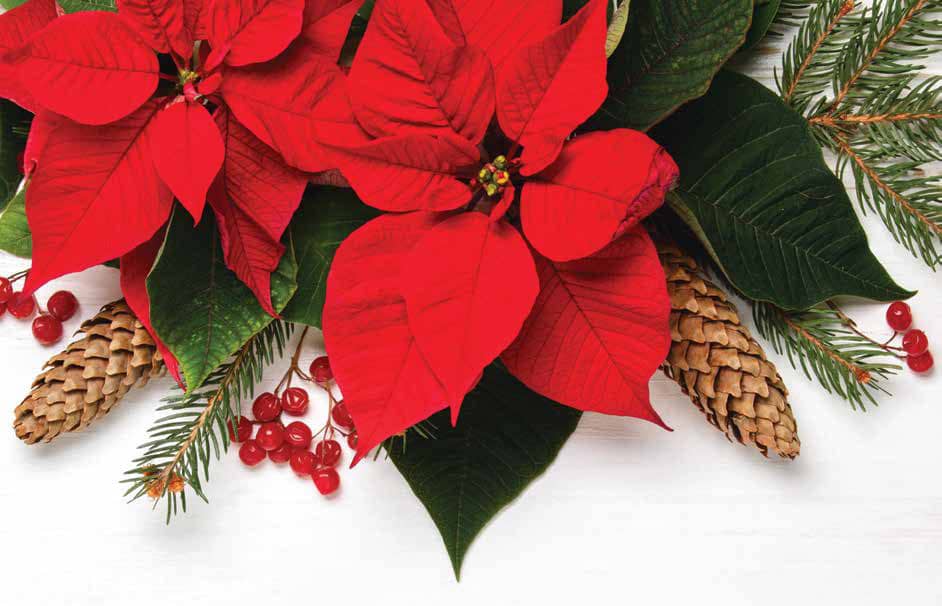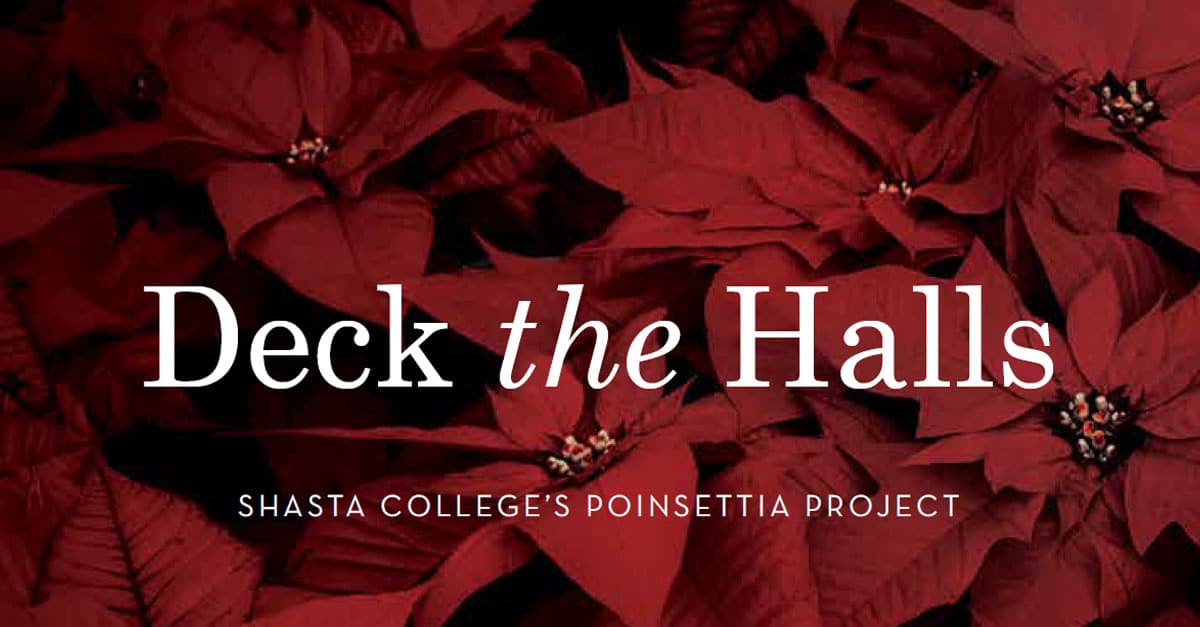Deck The Halls
Shasta College’s Poinsettia Project…
Not many plants look jolly in winter. The poinsettia is an exception. It dazzles in December, making it a holiday season favorite. “A lot of people have traditions built around them – emotional memories connected to poinsettias,” says Leimone Waite, horticulture instructor at Shasta College in Redding.
There’s a long tradition of growing poinsettias at Shasta College. Waite has centered a fall class around poinsettias for more than two decades, and the poinsettia project was in place prior to her arrival on campus. “It’s such an important part of our curriculum,” she says.
The poinsettia offers a multitude of lessons for horticulture students because it is a problem-prone plant. It doesn’t like to be too hot … or too cold. It suffers from root rot. And stem rot. It’s vulnerable to whiteflies. Too much nighttime humidity weakens leaves. Not enough
nighttime darkness prevents coloring. “They are one of the more difficult plants to grow,” Waite says. “They are just sensitive to everything.”
Students start with tiny rooted cuttings and – if all goes well – end up with robust, cheery plants ready for sale. Normally students grow 1,000 plants. This year the number is down to 200 because of uncertainty related to the pandemic, Waite says. The plan is to sell the poinsettias at Shasta College’s annual Christmas tree sale.
Each plant at the sale will represent weeks of work and problem-solving by the students. After the cuttings are potted, a beneficial mycorrhizal fungi drench is applied to the potting medium to discourage root and stem rot. Sticky traps are placed in the greenhouse to monitor for the dreaded whitefly. If whiteflies show up, lacewings are released to control the pests.
Students carefully check plant growth and, at a specific stage, pinch back dominant shoots. “It makes the plant much fuller,” Waite explains. “Otherwise it’s just a big stalk with a few leaves off to the side.”
Redding weather is a challenge. Poinsettias much prefer the even-keeled climate of a place like San Diego. The growing season in Redding swings from the blistering heat of August to the chill of December.

To color properly, poinsettias need to be in complete darkness at night for several weeks. Waite recalls one year when the faraway lights from the football field were enough to cause poinsettias in the greenhouse to resist turning color. Such situations have become less of a concern in recent years with the development of new poinsettia cultivars that are less persnickety about darkness hours.
New cultivars also have resulted in holiday plants that go well beyond the traditional reds, whites and pinks of the past. Poinsettias now can be found in burgundy, orange, variegated, marbled, speckled and miniature varieties.
Botanically speaking, the poinsettia is Euphorbia pulcherrima. It grows as a tall shrub in its homeland of Mexico. Joel Roberts Poinsett, the first United States ambassador to Mexico, introduced the plant to the United States in 1828. By 1920, Paul Ecke Sr. of Southern California had developed the first indoor, smaller version of the wild plant. Its Christmas popularity took off with a marketing push by Paul Ecke Jr. to get poinsettias featured in holiday television specials and movies.
A poinsettia appears to be a big, bold flower, but the colorful, showy part is made up of bracts – modified leaves. At the center of the bracts is the actual tiny, yellow flower. When buying a poinsettia, look for one with the flower still in the bud stage, Waite advises. “That means it’s fresher, will last longer and won’t drop its leaves as soon.”
Poinsettias are not toxic, although you wouldn’t want to munch on one. Ingesting plant parts can cause stomach upset. And the sap can be an irritant, according to the Mayo Clinic. Allergic reactions are more common among those with latex allergies.
To keep a poinsettia looking festive through the holiday season, place it in a spot that gets light but isn’t in direct sunlight. “The biggest mistake is putting it in front of a heating duct. They do not like air blowing on them,” Waite says. When watering, remove the decorative pot sleeve and water thoroughly in the sink, allowing the water to drain. “You do not want them to sit in water in those pot covers,” Waite warns.
It’s possible to have your Christmas poinsettia soldier on after the holiday season to return the following year as a seasonal decoration. But keeping the plant alive and looking happy requires a lot of effort, including repotting, maintaining a careful watering and fertilizing schedule, moving the plant outdoors and then back indoors, and restricting it to a dark room at nighttime for weeks in autumn.
“I just tell people, ‘Come buy another one from us,’” Waite says.




